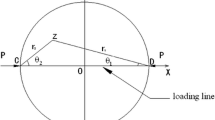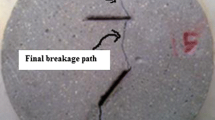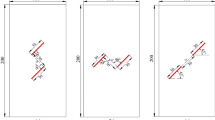Abstract
In the present study, fracture initiation and propagation from a pre-existing plane interface in a Brazilian disc is investigated using a finite-discrete element combined method. Different fracture patterns, depending on the frictional resistance of the pre-existing crack or interface, are observed from the numerical simulation. It is found that when there is no or very little frictional resistance on the surfaces of the pre-existing crack, the primary fractures (wing cracks), which are tensile in nature and are at roughly right angles to the pre-existing crack, start from the tips of the pre-existing crack. As the friction coefficient increases, the wing cracks’ initiation locations deviate from the crack tips and move toward the disc center. Secondary fractures, which are also tensile in nature, initiate from the disc boundary and occur only when the length of the pre-existing crack is sufficiently long. The secondary fractures are roughly sub-parallel to the pre-existing crack. The failure load is found to be influenced by the friction coefficient of the pre-existing crack. A 38 % failure load increase can result when the friction coefficient changes from 0 to 1. A good understanding of the fracture initiation and propagation in the forms of primary and secondary fractures provides insight into explaining some fracture patterns observed underground.














Similar content being viewed by others
References
Ashby MF, Hallam SD (1986) The failure of brittle solids containing small cracks under compressive stress states. Acta Metall 34(3):497–510
Atkinson C, Smelser RE, Sanchez J (1982) Combined mode fracture via the cracked Brazilian disc test. Int J Fracture 18:279–291
Awaji H, Sato S (1978) Combined mode fracture toughness measurement by the disc test. J Eng Mater Technol 100:175–182
Basista M, Gross D (1998) The sliding crack model of brittle deformation: an internal variable approach. Int J Solids Struct 35(5–6):487–509
Berenbaum R, Brodie I (1959) Measurement of the tensile strength of brittle materials. Br J Appl Phys 10:281–286
Bobet A (2000) The initiation of secondary cracks in compression. Eng Fract Mech 66(2):187–219
Bobet A, Einstein HH (1998) Fracture coalescence in rock-type materials under uniaxial and biaxial compression. Int J Rock Mech Min Sci 35(7):863–888
Bouchard PO, Bay F, Chastel Y, Tovena I (2000) Crack propagation modelling using an advanced remeshing technique. Comput Methods Appl Mech Eng 189(3):723–742
Cai M (2008) Influence of intermediate principal stress on rock fracturing and strength near excavation boundaries—insight from numerical modeling. Int J Rock Mech Min Sci 45(5):763–772
Cai M, Kaiser PK (2004) Numerical simulation of the Brazilian test and the tensile strength of anisotropic rocks and rocks with pre-existing cracks. Int J Rock Mech Min Sci 41(Supplement 1):478–483
Castro L (2004) Qualitative risk assessment applied to drifts or tunnels. AMQ-Colloque en controle de terrain, In
Chen CS, Pan E, Amadei B (1998) Fracture mechanics analysis of cracked discs of anisotropic rock using the boundary element method. Int J Rock Mech Min Sci 35(2):195–218
Cotterell B, Rice JR (1980) Slightly curved or kinked cracks. Int J Fract 16:155–169
Cottrell MG, Yu J, Owen DRJ (2003) The adaptive and erosive numerical modelling of confined boron carbide subjected to large-scale dynamic loadings with element conversion to undeformable meshless particles. Int J Impact Eng 28(9):1017–1035
Cundall, P. A. (1971) A computer model for simulating progressive, large scale movements in blocky rock systems. In: Proceedings of the International Symposium Rock Fracture, Nancy, Paper No. II-8
Eberhardt E, Stead D, Coggan JS (2004) Numerical analysis of initiation and progressive failure in natural rock slopes—the 1991 Randa rockslide. Int J Rock Mech Min Sci 41(1):69–87
Elmo D, Rogers S, Beddoes R (2011) Numerical analysis of caving mechanism using a hybrid FEM/DEM approach: experience gained and lessons learned. In: 45th US Symposium Rock Mech, San Francisco
Erdogan F, Sih GC (1963) On the crack extension in plates under plane loading and transverse shear. J Basic Eng 85:519–527
Fett T (2001) Stress intensity factors and T-stress for internally cracked circular disks under various boundary conditions. Eng Fract Mech 68:1119–1136
Horii H, Nemat-Nasser S (1985) Compression-induced microcrack growth in brittle solids: axial splitting and shear failure. J Geophys Res 90(B4):3105–3125
Kemeny JM, Cook NGW (1987) “Crack models for the failure of rocks in compression.” Constitutive laws for engineering materials: theory and applications, Elsevier, pp 879–887
Klerck PA (2000) The finite element modelling of discrete fracture of quasi-brittle materials. PhD thesis, University of Wales, Swansea
Klerck PA, Sellers EJ, Owen DRJ (2004) Discrete fracture in quasi-brittle materials under compressive and tensile stress states. Comput Methods Appl Mech Eng 193(27–29):3035–3056
Lavrov A, Vervoort A, Wevers M, Napier JAL (2002) Experimental and numerical study of the Kaiser effect in cyclic Brazilian tests with disk rotation. Int J Rock Mech Min Sci 39(3):287–302
Lee SS (1996) Analysis of crack closure problem using the dual boundary element method. Int J Fract 77:323–336
Lee S, Ravichandran G (2003) Crack initiation in brittle solids under multiaxial compression. Eng Fract Mech 70(13):1645–1658
Liu SB, Tan CL (1992) Two-dimensional boundary element contact mechanics analysis of angled crack problems. Eng Fract Mech 42:273–288
Ma GW, An XM, Zhang HH, Li LX (2009) Modeling complex crack problems using the numerical manifold method. Int J Fract 151(1):21–35
Malan DF, Napier JAL, Watson BP (1994) Propagation of fractures from an interface in a Brazilian test specimen. Int J Rock Mech Min Sci Geomech Abstr 31(6):581–596
Munjiza A, Owen DRJ, Bicanic NA (1995) A combined finite-discrete element method in transient dynamics of fracturing solid. Int J Eng Comput 12:147–174
Ortlepp WD (1997) Rock fracture and rockbursts—an illustrative study. The South African Institute of Mining and Metallurgy, Johannesburg, p 98
Pan XD, Reed MB (1991) A coupled distinct element-finite element method for large deformation analysis of rock masses. Int J Rock Mech Min Sci Geomech Abstr 28(1):93–99
Peng SD, Johnson AM (1972) Crack growth and faulting in cylindrical specimens of Chelmsford granite. Int J Rock Mech Min Sci Geomech Abstr 9:37–86
Phan AV, Napier JAL, Gray LJ, Kaplan T (2003) Symmetric-Galerkin BEM simulation of fracture with frictional contact. Int J Numer Meth Eng 57:835–851
Pine RJ, Coggan JS, Flynn ZN, Elmo D (2006) The development of a new numerical modelling approach for naturally fractured rock masses. Rock Mech Rock Eng 39(5):395–419
Rance JM, van As A, Owen DRJ, Feng YT, Pine RJ (2007) Computational modeling of multiple fragmentation in rock masses with application to block caving. In: Proceedings 1st Canada-U.S. Rock Mechanics Symposium, Taylor & Francis, Vancouver, pp 477–484
Roberts DP, Sellers EJ, Sevume C (1999) Numerical modelling of fracture zone development and support interaction for a deep level tunnel in a stratified rockmass. In: SARES 99. SANIRE, 1999, Johannesburg, pp 264–272
Rockfield Software Ltd. (2003) ELFEN Explicit user manual. Version 3.7. Swansea, UK
Shen B, Stephansson O, Einstein H, Ghahreman B (1995) Coalescence of fracture under shear stresses in experiments. J Geophys Res 100(B4):5975–5990
Shetty DK, Rosenfield AR, Duckworth WH (1987) Mixed-mode fracture in biaxial stress state: application of the diametral-compression (Brazilian disk) test. Eng Fract Mech 26(6):825–840
Shi G (1988) Discontinuous deformation analysis—a new numerical model for the statics, dynamics of block systems. PhD thesis, University of California, Berkeley, USA
Shi GH (1991) Manifold method of material analysis. In: Trans 9th Army Conf on Applied Mathematics and Computing, Minneapolis, Minnesota, pp 57–76
Sih GC (1991) Mechanics of fracture initiation and propagation: surface and volume energy density applied as failure criterion. Kluwer Academic Publishers, Netherlands, p 409
Tsay RJ, Chiou YJ, Chuang WL (1999) Crack growth prediction by manifold method. J Eng Mech 125:884–890
Tuhkuri J (1997) Dual boundary element analysis of closed cracks. Int J Numer Meth Eng 40(16):2995–3014
Van de Steen B, Vervoort A, Sahin K (2002) Influence of internal structure of crinoidal limestone on fracture paths. Eng Geol 67(1–2):109–125
Wang QZ, Xing L (1999) Determination of fracture toughness K IC by using the flattened Brazilian disk specimen for rocks. Eng Fract Mech 64(2):193–201
Wong LNY, Einstein HH (2009) Systematic evaluation of cracking behavior in specimens containing single flaws under uniaxial compression. Int J Rock Mech Min Sci 46(2):239–249
Yang SQ, Jing HW (2010) Strength failure and crack coalescence behavior of brittle sandstone samples containing a single fissure under uniaxial compression. Int J Fract 168(2):227–250
Yu JA (1999) Contact interaction framework for numerical simulation of multi-body problems, aspects of damage and fracture for brittle materials. PhD thesis, University of Wales, Swansea
Author information
Authors and Affiliations
Corresponding author
Rights and permissions
About this article
Cite this article
Cai, M. Fracture Initiation and Propagation in a Brazilian Disc with a Plane Interface: a Numerical Study. Rock Mech Rock Eng 46, 289–302 (2013). https://doi.org/10.1007/s00603-012-0331-1
Received:
Accepted:
Published:
Issue Date:
DOI: https://doi.org/10.1007/s00603-012-0331-1




